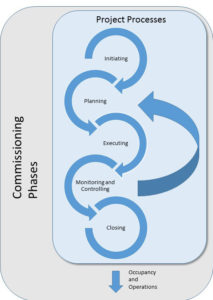I’m closing out the year by discussing a subject that I think needs to hit the mainstream already! Commissioning (Cx) – it’s too often overlooked. I could write pages and pages on this stuff so definitely look for future posts on the issue. For today, an introduction on the importance of commissioning:
What Exactly IS Commissioning?
When planning this post I asked a few people what their associations were with the term.
…“Like in ship building?”
Exactly. The immediate association was with “building things” and then to “having things built” (the latter indicates an ownership perspective). More or less along the right path – it seems to be a process that most people are aware of but aren’t particularly familiar with.
Commissioning started out as a practice in naval construction. It oversaw the building of a ship with the intention of making sure the ship was seaworthy before it ever hit the water. Failure was expensive and possibly unsalvageable – clearly best to be avoided.
Moving on to the construction industry – commissioning was first practiced on construction projects by Public Works Canada. ASHRAE was the next major proponent by developing a guideline for the commissioning of HVAC systems. A decade later, the USGBC provided a major boost when they added commissioning to LEED criteria.
So,
Why Commission?
Why not just make a list of specs and go on and build? Well…you could do that (and many people do) but will probably quite quickly learn that a lot can go wrong.
WORSE than things going wrong is when things go wrong and no one notices (or someone notices but the issue is ignored/buried/denied).
Commissioning is intended to protect the interest of the owner by assuring that a project is delivered and can be operated to meet the stated project requirements. It aims to prevent issues by ensuring that the design and construction are subject to checks from the beginning. One way to look at commissioning is to consider it as the establishment of iterative quality assurance processes throughout the LIFECYCLE of the building. The iterative nature of commissioning prevents costly corrections
It also happens to make sure that the Owner Project Requirements (OPRs) are clearly established in the first place. Handy, that.
Now,
How Do You Commission a Project?
Commissioning is a process that can begin even before you have a formalized project. A commissioning lead, typically known as the commissioning authority (CxA), should be appointed early and should be available to work with the owner, the design team and the construction team throughout the project.
As I mentioned above, the OPRs must be established early as they dictate the project scope and key design requirements. Other typical commissioning requirements are:
- Identifying a CxA
- Development and implementation of a commissioning plan (parties involved, schedule, tasks)
- Outline of commissioning specifications (expectations) to be included in bid documents
- Quality and performance checks and verifications of construction and installations
- Developing an operations and maintenance manual
- Post-occupancy/warranty review
This is getting somewhat technical, I know. It conveniently leads me to the question I want you to consider,
Who Should Manage the Commissioning?
A broad knowledge base is required for the delivery commissioning process to be reliably executed. The CxA may be appointed internally or externally and may be a person, team or firm. Specific requirements of this position vary depending on the needs of the project and any certifications that are being sought. A LEED project, for example has specific requirements (I’ll discuss commissioning in a LEED context another day).
While there are certifications for both professionals and organizations the most important qualification is knowledge and experience.
For a large or complex project you should definitely consider the services of professionals with expertise in the field either to handle the entire commissioning process or as a consultancy resource.
With the CxA identified, commissioning then proceeds through all stages of the project from initialization/pre-design right through to the handover. The CxA stays involved past project completion and into the operations phase by working with the building operations and maintenance teams to ensure smooth operation.
What else should you know?
Commissioning is not just a process for new buildings. If you are taking ownership of an existing building OR are in ownership of a building that is experiencing issues, recommissioning or retrocommissioning applies the process of commissioning to an existing building. These open an avenue for addressing, in a manner sustainable over the long term, problems that resulted from design or construction issues or that have developed over the lifetime of the building.
Talk to us about our commissioning services or ask about we can integrate commissioning with your ongoing project.









